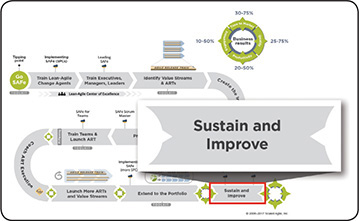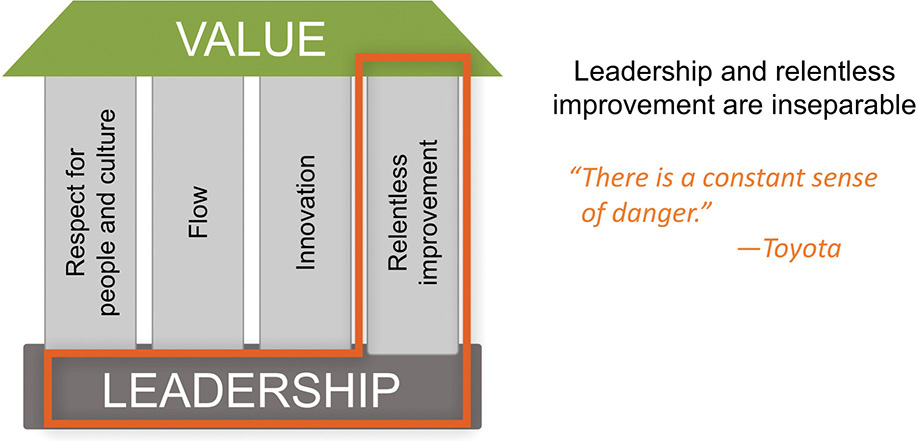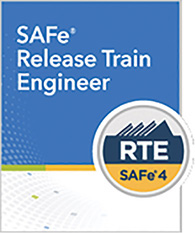

Excellent firms don’t believe in excellence—only in constant improvement and constant change.
—Tom Peters
If you’ve followed the previous 11 steps in the SAFe Implementation Roadmap, congratulations! You have made substantial progress on this portion of your Lean-Agile transformation journey. Your accomplishments are many. A sufficiently powerful coalition of change agents is in place. The majority of stakeholders are trained. Agile Release Trains (ARTs) and Value Streams are transformed and delivering value. The new way of working is becoming a part of the culture all the way from the team to the portfolio level.
By now, substantial business benefits are accumulating every day. Improvements in quality, productivity, time-to-market, and employee engagement are meeting or exceeding expectations. So how do you sustain this trend over the long term? It’s important to recognize that culture change can lose momentum as the ‘new car smell’ of a new initiative begins to fade.
To continue the practice of SAFe effectively, and ensure the ongoing engagement of the workforce, leaders must now expand their view of the implementation. They will need to maintain the energy and enthusiasm they are devoting to the short cycles of Iterations and Program Increments (PIs), while setting their sights on the distant horizon of long-term sustainability. The mindset and process of relentless improvement must now take root. This, of course, is synonymous with continuous change—a quest that can prove challenging for an enterprise.
In this chapter, we’ll suggest some key activities the enterprise can use to continuously sustain and improve its business performance.
Getting to this last step of the Implementation Roadmap is the beginning of another journey, one of relentless improvement. By now, the emerging Lean-Agile enterprise will have started to build a new operating model and culture, one in which relentless improvement is beginning to be the norm—but that state can’t be taken for granted.
Sustaining and improving upon the benefits gained require dedication to basic and advanced practices, self-reflection, and retrospection. Here are a number of activities the enterprise can use to ensure relentless improvement:
Foster relentless improvement and the Lean-Agile Mindset
Implement Agile Human Resources (HR) practices
Advance program execution and servant leadership skills
Measure and take action
Improve Agile technical practices
Focus on Agile Architecture practices
Improve DevOps and continuous delivery capability
Reduce time-to-market with value stream mapping
Each of these activities is described in the following sections.
The effort continues right where it began with relentless improvement, Lean-Agile leadership, and the Lean-Agile mindset. Figure 1 illustrates the direct connection between leadership and relentless improvement.

Figure 1. Lean leadership is the foundation for relentless improvement; you can’t have one without the other
Extending the benefits requires that leaders set an example by providing a continuous sense of urgency for change.
No matter how extensive the rollout training was, it likely did not reach all of the stakeholders who need to understand and embrace the new way of working—in operations, HR, legal, finance and accounting, sales, marketing, and more.
If these key stakeholders don’t understand or agree with the new culture, the transformation may continue, but you’ll be driving with the brakes on. In other words, you’ll have a traditional, non-Agile governance model working next to, but not integrated with, a Lean-Agile development workforce. Now is the time to extend the knowledge and culture by teaching Leading SAFe to all relevant stakeholders.
Earlier in Part 2, we described the Lean-Agile Center of Excellence (LACE) as the engine of the “sufficiently powerful coalition for change.” When the LACE is first established, its primary role is to implement the new way of working within the organization. Once that goal has been accomplished, the LACE becomes a long-lived center, a persistent energy source for continuous improvement.
As influential as it might be, the LACE is only one element of the coalition. If the enterprise is to effectively sustain and improve its operations, additional help is needed. As described in previous chapters, SAFe organizes people with different skills around a value stream. Organizing this way can have an unintended consequence: It can limit the opportunities to share knowledge and learn new skills with other people in the same role. Communities of Practice (CoPs) help overcome this limitation by bringing people together around a subject domain, work roles, or other areas of common interest.
Respect for people is a pillar of the House of Lean. It is people, after all, who build these critical systems we all depend on. They go to work intrinsically motivated to build high-quality, innovative systems. Given the importance of their contributions, management’s challenge is to cultivate an environment in which they can prosper and do their best.
While SAFe provides many of the values and practices of that environment, it also puts extreme pressure on traditional human resources practices. It compels enterprises to embrace a new, Lean-Agile HR perspective to accommodate the modern knowledge worker. This new dynamic features six major themes:
Embrace a new talent contract, which explicitly acknowledges the need for value, autonomy, and empowerment.
Foster continuous engagement to both the business and technical mission.
Hire people for Agile attitude, team orientation, and cultural fit.
Eliminate annual performance reviews, replacing them with continuous, iterative performance feedback and evaluation.
Eliminate destructive individual financial incentives. Take the issue of money off the table by paying employees enough to focus on the work, not the money.
Support meaningful, impactful, and continuous learning and growth.
For more on this topic, read the SAFe guidance white paper, “Agile HR with SAFe: Bringing People Operations into the 21st Century with Lean-Agile Values and Principles”[2].
An effective SAFe implementation that leads to substantive results is built on effective Agile teams and ARTs. No roles are more important than Scrum Master and Release Train Engineer (RTE) when it comes to facilitation and servant leadership. Once these individuals become adept in handling their basic responsibilities, they will be ready to take the next step to advance and cultivate new skills.

Scaled Agile, Inc.’s two-day SAFe Advanced Scrum Master course with SASM certification prepares current Scrum Masters for their leadership role in facilitating Agile team, program, and enterprise success. The course covers facilitation of cross-team interactions in support of program execution and relentless improvement. It enhances the Scrum paradigm with scalable engineering and DevOps practices, as well as the application of Kanban to facilitate the flow and support of interactions with architects, product management, and other critical stakeholders. The course offers actionable tools for building high-performing teams and explores practical ways of addressing Agile and Scrum anti-patterns in the enterprise.

In a similar fashion, RTEs can improve their skills as Agile program managers, team coaches, and program-level facilitators. The SAFe Release Train Engineer course with RTE certification is designed just for this purpose.
In this three-day interactive course, attendees gain an in-depth understanding of the role and responsibilities of an RTE. They learn how to facilitate and enable end-to-end value delivery through ARTs and value streams. Attendees also learn how to build a high-performing ART by becoming a servant-leader and coach, and how to plan and execute a PI planning event (the primary enabler of alignment throughout all levels of a SAFe organization).
Peter Drucker is credited with saying, “What’s measured improves.” We haven’t focused much on measures as yet, but you can’t knowingly improve what you can’t measure. In this section we’ll take a quick look at a few of the many opportunities to measure and take action on the results.
Inspect and Adapt (I&A) is the cornerstone event of program improvement. Unlike simpler forms of retrospectives, these events bring the key stakeholders—the people who can change the systems in which everyone works—into a corrective action workshop. They offer an objective demonstration, measurement, and structured root cause analysis. Leaders must actively encourage and participate in I&A problem-solving. This closes the loop on the PI learning cycles and is the basis for continuously improving enterprise performance.
Lean-Agile development is inherently more measurable than other methods used in the past. The Metrics chapter highlights many of the measures that enterprises can apply to objectively evaluate their progress toward better outcomes.
People don’t generally like to be measured. After all, a person can be evaluated only by being compared to another person—and only the one at the top can feel good about that outcome.
What’s more, many measures traditionally applied to the development process and its workers are now obsolete. Being measured by others goes against empowered, self-managing Agile thinking.
Instead, we suggest that teams self-assess their progress against agreed-to Agile values. SAFe provides a set of self-assessment worksheets for the Team, Program, and Portfolio levels.
See the Metrics chapter in Part 6 (Spanning Palette) for sample radar charts, which are used to show the results of an assessment. (Note: The self-assessment worksheets can be downloaded at scaledagileframework.com/metrics/.)
We’ve often observed that within the first year or so of adoption of the SAFe Implementation Roadmap, teams can quickly reach an apparent velocity limit by implementing only the basic role and team project management practices. After that, further improvements in velocity and quality can occur through effective implementation of Agile technical practices.
Built-In Quality software practices include Continuous Integration, Test-First, and test automation. Mastering these practices takes an additional investment of time and focus, typically with the help of outside experts who have applied these practices in other contexts. Time must be allocated for this new learning to take place, and the Innovation and Planning (IP) iteration can often provide the dedicated time needed.
In addition, companies building really large and/or high-assurance systems need to focus on evolving fixed and variable Solution Intent and maintenance of architectural and other models that show how the system works. Implementing and advancing Model-Based Systems Engineering and Set-Based Design can help the enterprise develop and maintain these important artifacts.
For teams building high-assurance systems—where the cost of error is simply unacceptable—these practices should go all the way into, and through, verification, validation, and compliance. Guidance for these practices is described in the Compliance chapter.
Agile or not, it’s impossible to build significant world-class systems without some degree of intentional architecture. Today, however, the Big Design Up-front (BDUF) practices of waterfall development are no longer relevant.
In today’s enterprises, solution architecture must be evolved while building the solution. This includes creating the architectural underpinnings (Architectural Runway) and practices for incrementally evolving legacy systems into the new platforms of choice. In other words, we have to change the engine while driving to the destination.
Creating an Agile Architecture CoP can help the enterprise meet these challenges. This approach allows System and Enterprise Architects to come together to define and learn the leaner and more incremental approaches to establishing and evolving solution architecture, and to advancing their Agile architectural skills and craft. Along the way, the following topics are likely to be addressed:
Review and adopt the SAFe Seven Principles of Agile Architecture
Identify enabler Epics and Capabilities necessary to evolve the solution architecture
Identify methods of splitting architectural epics into enabler capabilities and Features for incremental implementation
Establish the decision-making framework and policies for architectural governance and capacity allocation
Identify relevant Nonfunctional Requirements (NFRs)
In many enterprises, such workshops are run on the PI cadence, often aligned with the innovation and planning iteration. This timing conveniently makes development teams available for fast feedback spikes to help establish the technical feasibility of design alternatives. It also supports the pressing need to prepare architectural concepts and models for review in the upcoming PI planning session.
Once ARTs are launched and value streams begin to operate better, the enterprise has greater visibility into the next set of bottlenecks and impediments. Often, ‘leaning out’ the development cycle just moves the bottleneck farther down the value stream toward release and deployment. Since DevOps is integral to the value stream, SAFe ARTs include operations and maintenance personnel and can release value independently. Together, they focus on improving delivery speed via a Continuous Delivery Pipeline. A number of recommended practices are described in the DevOps chapter, which involve shifting the company mindset and enabling a collaborative environment. This requires strong leadership from managers and subject-matter experts with the authority to create a culture for continuous value delivery. CoPs can also play a leading role in this effort.
Identifying the value streams and organizing release trains around them delivers another significant benefit: Each value stream provides an identifiable and measurable flow of value to a Customer. As such, it can be systematically improved to increase delivery velocity and quality.
The value stream is the most important organizational construct in SAFe. ‘Taking a systems view of value delivery’ means understanding all the steps from ideation and feature approval to development through deployment, all the way to release. The total average time for all these steps, including the delay times, is the average time-to-market for any new feature. This gives us one more important tool in our toolbox: the process of value stream mapping, an analytical process that teams can use to first understand, and then improve, time-to-market.
An important process, as the SAFe enterprise matures its thinking, is to map the value stream and make continuous improvements. The steps are as follows:
From the receipt of the customer request to the solution’s release, map the current state by identifying all the steps, value-added times, handoffs, and delays.
Identify the largest sources of delays and handoffs as the feature moves through the system.
Pick the biggest delay. Perform root cause analysis. Create improvement backlog items to reduce the delay. Reduce batch sizes wherever possible.
Implement the new improvement backlog items.
Measure again, and repeat the process.
Using this process, the maturing Lean enterprise can systematically improve time-to-market aggressively and continuously for its own benefit. For example, what if the ride management system value stream/ART of Figure 2 was always the critical path, and even when the vehicle was ready for shipment the ride management software was not? That would be a high cost of delay!
In this case, the ride management ART would apply value stream mapping to identify the steps and flow through the system, and they might describe a flow such as that illustrated in Figure 2. The teams would quickly see that the amount of value-added touch time is only a small portion of the overall time it takes to deliver the end result. After all, it took them only 11 hours of work to create the new feature, yet it took seven weeks to deliver it! As the value stream mapping shows, the majority of the time is spent in handoffs and delays. The team members have been working hard, and apparently efficiently from the touch time, yet the overall flow through the system could not meet the demand. Coding and testing faster won’t help. Rather, the teams must take the systems view and focus on the delays.
Reducing delays in the value stream is always the fastest way to reduce time-to-market.
LEARN MORE
[1] Martin, Karen, and Mike Osterling. Value Stream Mapping. McGraw-Hill, 2014.